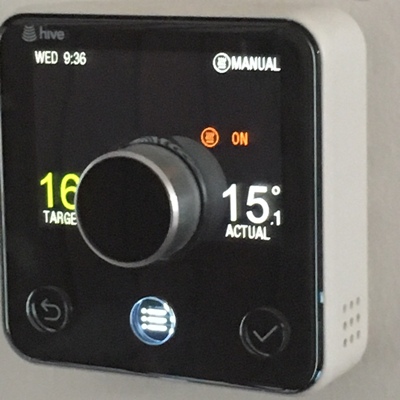Thermostat

|

|
| Smart thermostat | Thermostatic radiator valve (TRV) |
A thermostat is a component that forms part of a building’s controls, helping maintain a steady, pre-determined temperature. It does this by sensing the temperature of a system and adjusting the heating or cooling input to achieve a required set point. Thermostats are commonly used in central heating, air conditioning, HVAC system, water heaters, as well as devices such as fridges and ovens.
It is derived from the Greek words 'thermos' (meaning hot or heat) and 'stat' (meaning standing or stationary).
A thermostat works as a ‘closed loop’ control system, which is one in which the output has an effect upon the input to maintain a desired output value. It achieves this by providing a feedback loop. For example, a boiler may have a temperature thermostat which monitors the thermal comfort level of a building and sends a feedback signal to ensure the controller maintains the set temperature.
Common types of thermostat use bimetallic strips or gas-filled bellows.
A bimetallic strip consists of two pieces of different types of metal fixed together into a strip forming a bridge in an electrical circuit connected to a heating or cooling system. As the strip changes temperature, the two metals expand or contract differentially, bending or straightening the strip slightly and eventually breaking or closing the circuit and so activating or deactivating the heating or cooling system. A drawback of bimetallic strips is that they can be relatively slow to react to changes in temperature.
Gas-filled bellows are enclosed by a pair of metal discs. The gas in the bellows expands as temperature increases, forcing the discs apart and switching off the system. This type of thermostat is typically faster to react than a bimetallic strip thermostat.
Thermostats may operate independently, or as part of a more complex system. For example, Most domestic radiators will include a thermostatic radiator valve which gives local control over the amount of hot water that is allowed into the radiator. In addition, the boiler may have controls allowing the output water temperature from the boiler to be adjusted. There is then, typically a central thermostat that allows occupants to regulate the temperature of a building or part of it as a whole.
Some thermostats may be connected to other control systems such as timer devices, or more complex Building Automation and Control Systems (BACS).
More recently, there has been an increase in the popularity of 'smart' thermostats which allow a building’s temperature to be controlled remotely using a smartphone, tablet or other device. Users can programme the thermostat to turn the heating on or off at certain times, and some models can ‘intelligently’ learn about the building and how long is takes to heat up or cool down, as well as the preferences and habits of the occupants. This can help use energy more efficiently.
NB New regulations mean that from June 2022, heating installers are required to install thermostatic room controls when replacing a boiler.
NB Guide to Controls (BG 83/2023) written by John Marrow and published by BSRIA in June 2023, defines a thermostat as: ‘An independent temperature switching device which enables users to manually adjust a setpoint temperature for heating or cooling.’
[edit] Related articles on Designing Buildings
Featured articles and news
RTPI leader to become new CIOB Chief Executive Officer
Dr Victoria Hills MRTPI, FICE to take over after Caroline Gumble’s departure.
Social and affordable housing, a long term plan for delivery
The “Delivering a Decade of Renewal for Social and Affordable Housing” strategy sets out future path.
A change to adoptive architecture
Effects of global weather warming on architectural detailing, material choice and human interaction.
The proposed publicly owned and backed subsidiary of Homes England, to facilitate new homes.
How big is the problem and what can we do to mitigate the effects?
Overheating guidance and tools for building designers
A number of cool guides to help with the heat.
The UK's Modern Industrial Strategy: A 10 year plan
Previous consultation criticism, current key elements and general support with some persisting reservations.
Building Safety Regulator reforms
New roles, new staff and a new fast track service pave the way for a single construction regulator.
Architectural Technologist CPDs and Communications
CIAT CPD… and how you can do it!
Cooling centres and cool spaces
Managing extreme heat in cities by directing the public to places for heat stress relief and water sources.
Winter gardens: A brief history and warm variations
Extending the season with glass in different forms and terms.
Restoring Great Yarmouth's Winter Gardens
Transforming one of the least sustainable constructions imaginable.
Construction Skills Mission Board launch sector drive
Newly formed government and industry collaboration set strategy for recruiting an additional 100,000 construction workers a year.
New Architects Code comes into effect in September 2025
ARB Architects Code of Conduct and Practice available with ongoing consultation regarding guidance.
Welsh Skills Body (Medr) launches ambitious plan
The new skills body brings together funding and regulation of tertiary education and research for the devolved nation.
Paul Gandy FCIOB announced as next CIOB President
Former Tilbury Douglas CEO takes helm.
UK Infrastructure: A 10 Year Strategy. In brief with reactions
With the National Infrastructure and Service Transformation Authority (NISTA).






















